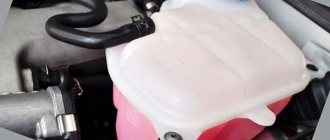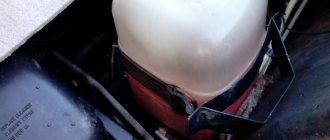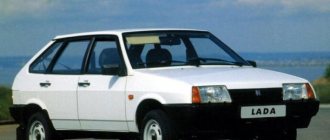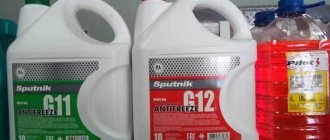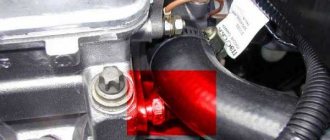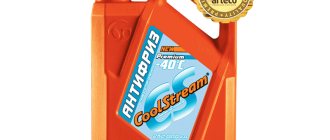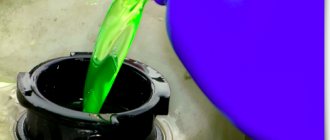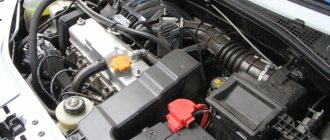When fuel burns in the engine, a significant amount of heat is released. Only a small part of it (30–40%, which corresponds to the efficiency of gasoline engines) is converted into mechanical energy, due to which the car is driven. Excess heat must be removed from the power unit through a liquid cooling system. Its performance directly depends on what kind of antifreeze in Grant is used during service. The quality and characteristics of the coolant affect not only the efficiency of heat removal, but also the frequency of its replacement. The better and more technologically advanced the composition, the longer the coolant retains its original characteristics, protecting the engine from overheating. This reduces the risk of thermal deformation of the cylinder head, gasket breakdown and other consequences that can lead to expensive engine overhauls.
What kind of liquid is poured into Granta at the factory?
When the car is factory assembled, the cooling system is filled with red coolant. Cars manufactured in 2011 use G12+ class coolant. Its estimated service life is 5 years or 75 thousand kilometers. Since 2012, Lada Granta cars have been filled with a more modern and wear-resistant composition of the G12++ class. Antifreezes are produced by several manufacturers who are partners and supply consumables for the primary maintenance of new cars. Car owners have the opportunity to choose a brand at their discretion. At the same time, it is important to use original quality products and purchase antifreeze only from trusted suppliers.
Summary
I hope this article describes the process of replacing the coolant solution in sufficient detail. But, however, many operations are carried out from below the car, and they need to be carried out either in a pit or on a lift.
So, if you don’t have a pit or a lift on your farm, then replacing it will be quite labor-intensive. You will need to jack up your car and be prepared to do a lot of the work while lying on your back under the car.
If you are not ready to endure these inconveniences, then in this case it is better for you to use the services of a service station. The operation of replacing the coolant solution itself is one of the cheapest in the service station price list.
How much fluid to pour into the system
When servicing a car, you need to know what kind of antifreeze to pour into the Granta, and how much working fluid should be in the cooling system circuit. The standard volume is 7.84 liters. For maintenance, two 4-liter coolant cans will be sufficient. Too little or too much antifreeze can have serious consequences. If there is not enough coolant in the line, this will negatively affect the cooling efficiency of the engine. The engine will heat up faster, and the temperature gauge on the dashboard may rise above the center position and even reach the red zone. If, on the contrary, there is more antifreeze in the system than indicated in the technical documentation for the car, this will lead to an increase in pressure in the circuit. Excess coolant will be released through the expansion tank plug, polluting the engine compartment. Also, due to increased pressure, breakdown of sealing gaskets or rupture of rubber cooling pipes may occur.
Is it possible to mix coolants?
Mixing different compounds that differ in markings, colors and brand names is a pressing problem for motorists. In some cases, it is necessary to add antifreeze to the system - for example, when it leaks through a pump, damaged pipes or a damaged radiator affected by corrosion. The same composition that is currently used in the car is not always at hand. Sometimes you have to turn to drivers passing by for help (if the breakdown occurs in the middle of the road). In such cases, there is no choice, and the car owner is forced to mix different antifreezes to prevent the engine from overheating. General recommendations are:
- G12+ compounds can be mixed with liquids of the same class or higher (G12++, G13), mixing with G11 antifreezes is not allowed;
- G12++ are more universal materials, compatible with any fluid from G11 to G13, they can be safely combined with each other.
How often should you change the fluid?
As it is used, antifreeze gradually loses its properties. Due to irreversible chemical reactions, the liquid may become cloudy and more viscous. If coolant is used in the system for a long time, it loses its heat dissipation characteristics and copes with its task worse. To ensure stable cooling of the power unit and to avoid the appearance of deposits in the pipes and radiator, the coolant should be changed in a timely manner. If the cooling system is in good condition and is not contaminated with foreign substances formed during the decomposition of used antifreeze, then it is enough to change the coolant once every 5 years. Such terms are relevant for high-quality original liquids of the G12+ class. G12++ compositions can be changed once every 7 years. If the antifreeze becomes cloudy before the specified period has expired, it should be replaced ahead of schedule. It is also necessary to flush the system so that contaminants remaining in the circuit after draining the old fluid do not enter the new coolant.
How to change antifreeze with your own hands
The motorist must not only know what kind of antifreeze should be poured into the Lada Granta during scheduled maintenance. To save on car service costs, you should also learn how to change the coolant yourself. The procedure is relatively simple.
- The car engine must cool down for excess pressure to leave the system. It is enough for it to cool down to 30–40 °C. It is not necessary to wait until it cools completely.
- Under the drain hole located at the bottom of the radiator, you need to place a container of 8–10 liters - for example, a bucket or basin. For convenience, it is better to place the car on an overpass or inspection hole.
- To prevent a vacuum from remaining in the system, which slows down the drainage of old coolant, you need to unscrew the filler plug at the top of the radiator. Then you can drain the antifreeze.
- It is also necessary to drain the fluid from the cylinder block if it has a drain hole.
- Next, you need to tighten the drain plugs and pour the required amount of antifreeze through the radiator.
Choices
When choosing, do not neglect the color of the liquid. The color is intended to indicate certain properties of the antifreeze, so replace it only with an option with an identical color.
Recommended brands of antifreeze include the following products:
Antifreeze from the above-mentioned manufacturers has proven itself quite well, so you can purchase it without the slightest hint of doubt.
Features of Sintec multifreeze
Motorists who use the universal Multifreeze composition do not have to waste time finding out what antifreeze was poured into the Lada Granta at the factory or during previous maintenance. The material is compatible with all types of coolants: G11, G12, G12+, G12+++ and G13, regardless of their color. Versatility and compatibility with different classes of coolant are not the only advantages of multifreeze. Its advantages include the following characteristics:
- durability. Multifreeze Sintec coolant can be used for the entire life of the vehicle, provided that the system has been fully serviced and flushed before adding fresh coolant.
- fluorescent additives. Multifreeze contains phosphorus impurities, which make it possible to detect leakage points using an ultraviolet lamp. This greatly simplifies the search for places where pipes and seals are depressurized in the engine liquid cooling system.
- chemical inertness. The composition does not have an aggressive effect on the metals that make up the water pump, motor and radiator.
We dismantle the radiator of the Lada Granta stove
Despite the fact that there are usually no complaints about the quality of the stove, breakdowns can still occur. If you focus on the radiator, it may clog or leak. In any case, you need to immediately begin dismantling the stove, after which it will be possible to inspect it in detail and understand the causes of the breakdown.
Most of the work will have to be done on the top of the engine compartment, as well as from inside the car. In fact, in this case we will not need a pit, a jack, or a lift. Just keep in mind that access to the engine compartment will be extremely difficult.
- To begin, unscrew a couple of clamps that secure the heater pipes to the heater radiator. This frees them up so we can remove the pipes completely.
- Now we will have access to draining the coolant from the radiator. Naturally, you will have to take care in advance of the container where this liquid will be drained.
- If possible, we move the pipes to the side. In principle, most of the work in the engine compartment is completed here.
- Next comes work from inside the car. Near the handbrake you can find one self-tapping screw that secures the tunnel, as well as another self-tapping screw for fixing the parking brake housing. Unscrew them completely. In addition, on the driver's side and on the passenger's side there will be two more screws that secure the tunnel on both sides.
- Using a screwdriver, carefully remove the gear shift knob cover from the groove. At the same time, we lift the tunnel up a little, moving it to the left.
- We unscrew the nuts that secure the gas pedal, as well as the stand under it.
- Two more screws that secure the radiator cap casing must be unscrewed and put aside. The cover can now be completely removed to gain access to the radiator.
- Next you will have to saw it off. Only now the radiator can be removed by holding down the brake pedal, which will interfere.
Installation of a new Lada Granta radiator
The new radiator must be original or at least compatible with it in size and technical parameters.
After this, the new radiator will fit into place very well. All other parts are assembled in reverse order.
Selecting a new heater radiator (verified articles)
It is completely made of aluminum alloy, and the price of this radiator is about one and a half thousand rubles. In addition to the Lada Grant, it is also suitable for installation in the second version of the Lada Kalina.
In general, so far, alternatives are rarely found on the domestic market. So car enthusiasts have to be content with this radiator. However, it performs quite well, especially if you do not use special additives to “repair” it, which seal the liquid supply channels.
Radiators of the so-called new type are characterized by mounting features. In addition, such radiators are not solid, but consist of two parts. They are assembled together using three self-tapping screws.
As for the “old” radiator model, it has a completely solid structure. However, most of the fastening elements are the same as the new type, so installing any of them should not lead to any difficulties.
Antifreeze Lux G12 and Premium G12+ from Sintec
The Sintek brand also produces all-season coolants Lux G12 and Premium G12+, which can be used in Lada Vesta cars with any type of engine. G12 antifreeze contains innovative carbon additives that improve thermal conductivity characteristics and increase the protection of metal surfaces from corrosion. The G12+ Premium composition is produced using carboxylate additives, which increase the service life of the coolant and form a protective film on the parts of the cooling system.
What antifreeze to choose for VAZ (Lada) Granta?
Last month, PartReview users preferred SINTEC. 60% of positive votes belong to this manufacturer.
FELIX antifreeze took second place – 40%.
In the general rating of antifreeze, which takes into account the opinions of owners of different brands and models of cars, these brands occupy the following positions:
- SINTEC received 6th place, PR score – 88. Data from 143 reviews and 447 votes are taken into account.
- FELIX took 16th place, with a PR score of 70. Based on 143 reviews and 457 votes.
You may also be interested
What antifreeze to fill in Lada Vesta
The efficiency of the system depends on the quality and properties of the coolant (coolant) poured in. It is characterized by natural evaporation, so periodically it requires topping up to the level indicated on the expansion tank. If you know what kind of antifreeze is poured into the Lada Vesta at the factory, then you can choose the right technical fluid that will be compatible with the “native” coolant.
What antifreeze to fill in Kia Rio
The coolant loses its properties during vehicle operation and therefore must be replaced at the interval specified by the car manufacturer or earlier if the system is repaired. To replace technical fluid, it is important to figure out what kind of antifreeze to pour into the car.
Antifreeze
Many drivers believe that antifreeze is a separate type of coolant, different from traditional types of antifreeze, but this is not so. Antifreeze is a liquid developed by the domestic enterprise Organic Synthesis Technologies. Hence the name that the coolant received. TOS is an abbreviation for the developer, and the ending “OL” is an indication that it belongs to alcoholic liquids. During the Soviet period, there was no need for a patent on the name, so almost all car coolants produced in the USSR, and then in Russia, were called the same - “Tosol”, which, in fact, is a domestic antifreeze.
How often to change antifreeze is traditionally indicated on the packaging by the manufacturer. The frequency of replacement of domestic coolant, as a rule, does not exceed 2 years.

